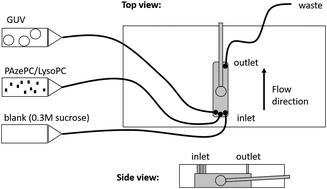当前位置:
X-MOL 学术
›
Soft Matter
›
论文详情
Our official English website, www.x-mol.net, welcomes your
feedback! (Note: you will need to create a separate account there.)
Asymmetric desorption of lipid oxidation products induces membrane bending
Soft Matter ( IF 2.9 ) Pub Date : 2021-07-26 , DOI: 10.1039/d1sm00652e Rui Jin 1 , Tobias Baumgart
Soft Matter ( IF 2.9 ) Pub Date : 2021-07-26 , DOI: 10.1039/d1sm00652e Rui Jin 1 , Tobias Baumgart
Affiliation

|
Lipid oxidation, detected in metabolic processes, is induced in excess when the cellular membrane suffers extra oxidative stress. Lipid oxidation can compromise biomembrane function in part through perturbations of lipid packing, membrane permeability, and morphology. Two major types of oxidation products, one with a partially truncated lipid tail with a hydrophilic group at the tail-end, and secondly, a lysolipid (with one of the chains completely truncated) can disturb the membrane bilayer packing significantly. However, they also have an increased tendency to desorb from the membrane. In this study we investigated desorption kinetics of two characteristic lipid oxidation products (PAzePC and 18 : 1 LysoPC) from a model membrane system, and we evaluated the consequences of this process on membrane shape transitions. Using a microfluidic chamber coupled with micropipette aspiration, we observed the incorporation of the two lipids into the membrane of a giant unilamellar vesicle (GUV) and further determined their desorption rates, association rates and flip-flop rates. For both lipids, the desorption is on the time scale of seconds, one to two orders of magnitude faster than their flipping rates. Dilution of the outer solution of the GUVs allowed asymmetric desorption of these two lipids from the GUVs. This process induced lipid number asymmetry and charge asymmetry, specifically for PAzePC containing GUVs, and caused membrane tubulation. Our results indicate that the desorption of lipid oxidation products can alter the local structure of biomembranes and result in morphological changes that may relate to membrane function.
中文翻译:

脂质氧化产物的不对称解吸引起膜弯曲
当细胞膜遭受额外的氧化应激时,在代谢过程中检测到的脂质氧化会被过度诱导。脂质氧化可部分通过扰动脂质堆积、膜通透性和形态来损害生物膜功能。两种主要类型的氧化产物,一种具有部分截断的脂质尾部,末端有亲水基团,第二种是溶血脂(其中一条链完全截断)可以显着干扰膜双层堆积。然而,它们从膜上解吸的趋势也增加。在这项研究中,我们研究了模型膜系统中两种特征性脂质氧化产物(PAzePC 和 18:1 LysoPC)的解吸动力学,并评估了该过程对膜形状转变的影响。使用微流体室与微吸管抽吸相结合,我们观察到两种脂质掺入巨型单层囊泡(GUV)的膜中,并进一步确定了它们的解吸率、结合率和翻转率。对于这两种脂质,解吸的时间尺度为秒,比它们的翻转速率快一到两个数量级。GUV 外部溶液的稀释允许这两种脂质从 GUV 中不对称解吸。这个过程引起脂质数量不对称和电荷不对称,特别是对于含有 GUV 的 PAzePC,并引起膜管状现象。我们的结果表明,脂质氧化产物的解吸可以改变生物膜的局部结构,并导致可能与膜功能相关的形态变化。
更新日期:2021-08-02
中文翻译:

脂质氧化产物的不对称解吸引起膜弯曲
当细胞膜遭受额外的氧化应激时,在代谢过程中检测到的脂质氧化会被过度诱导。脂质氧化可部分通过扰动脂质堆积、膜通透性和形态来损害生物膜功能。两种主要类型的氧化产物,一种具有部分截断的脂质尾部,末端有亲水基团,第二种是溶血脂(其中一条链完全截断)可以显着干扰膜双层堆积。然而,它们从膜上解吸的趋势也增加。在这项研究中,我们研究了模型膜系统中两种特征性脂质氧化产物(PAzePC 和 18:1 LysoPC)的解吸动力学,并评估了该过程对膜形状转变的影响。使用微流体室与微吸管抽吸相结合,我们观察到两种脂质掺入巨型单层囊泡(GUV)的膜中,并进一步确定了它们的解吸率、结合率和翻转率。对于这两种脂质,解吸的时间尺度为秒,比它们的翻转速率快一到两个数量级。GUV 外部溶液的稀释允许这两种脂质从 GUV 中不对称解吸。这个过程引起脂质数量不对称和电荷不对称,特别是对于含有 GUV 的 PAzePC,并引起膜管状现象。我们的结果表明,脂质氧化产物的解吸可以改变生物膜的局部结构,并导致可能与膜功能相关的形态变化。











































 京公网安备 11010802027423号
京公网安备 11010802027423号